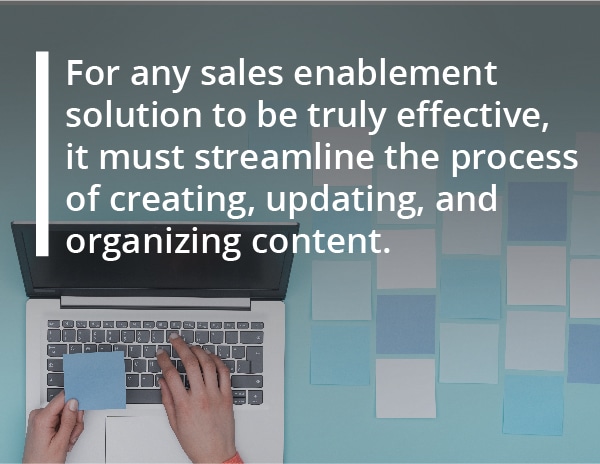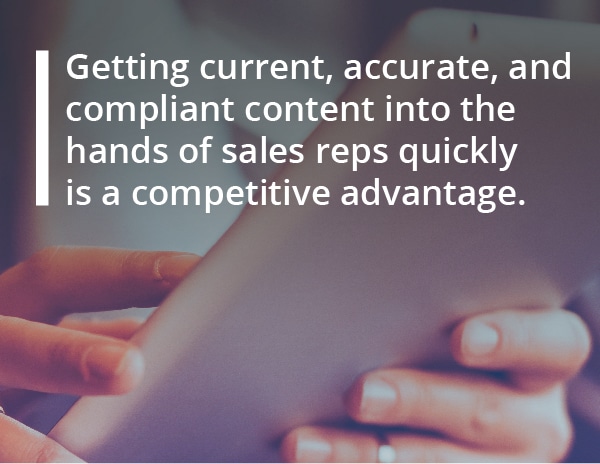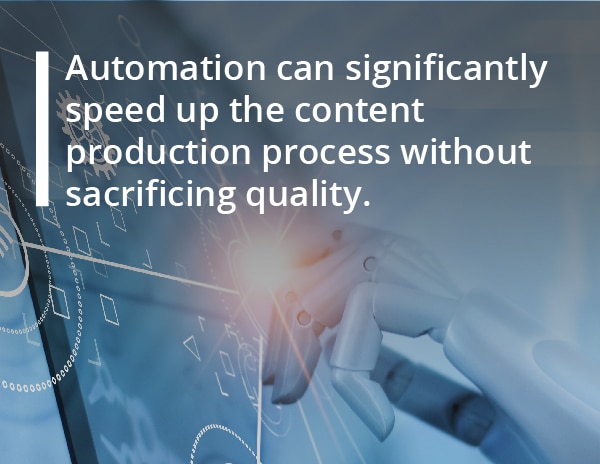Sales enablement is a critical component of the marketing strategy for many B2B companies. A robust sales enablement strategy can completely transform the way your team sells, leading to better customer-centricity, sales productivity, and win rates. With sales enablement technology adoption on the rise, many leading marketing teams are looking for the right solution to add to their tech stack.
To help, we’ve compiled the most important considerations for ensuring the sales enablement technology you deploy is optimized for success. How does it fit within your sales tech ecosystem? Will your content drive the positive sales outcomes you’re seeking? Read on to learn more.
Dynamic content is crucial to sales success

Producing quality content is especially critical for regulated and highly competitive industries like financial services. At investment management firms, the ability to create both a positive brand image and client-centric experience drives important competitive differentiation. Because of this, much of the content used by investment sales reps is dynamic, meaning the data is constantly changing. Fact sheets, presentation decks, and portfolio commentaries are commonly used in pitches to institutional and financial advisor clients. The variety of content contains performance, attribution, and holdings data, as well as disclosures that must be kept up-to-date. These cycles can be very time and resource intensive for financial services marketers. For this reason, many look to automation capabilities to produce timely, relevant, and accurate content.

For companies in highly regulated industries like financial services, insurance, and healthcare, automation is an important piece of your sales enablement strategy. Getting current, accurate, and compliant content into the hands of sales reps quickly is a competitive advantage. It reduces the risk of sellers using inaccurate or out-of-date content during client engagements and enables them to access the right content at the right time.
Automation accelerates the sales process
Companies buried in data find it challenging to produce content quickly because of the time it takes to process (calculate, validate, and normalize) the data and deliver it to their marketing team. Automating data processing and autonomously pushing it into pre-designed templates containing mappings and business rules for how it should display can help scale marketing operations and save weeks or even months of valuable time. Providing recent and relevant fact sheets builds buyer confidence and credibility, helping your sales reps to move deals forward.
Automation protects brand reputation

Note that there are different approaches to content automation which can affect the quality and timeline of your project. Read about them here.

In highly regulated industries, automated systems for sales presentation management are integral to your sales and marketing functions. Historically, investment sellers have been forced to pitch with standard, static sales decks with 100+ slides and –gasp– printed out! Digital sales enablement technology has evolved the experience for both buyer and seller. Sales reps are now able to pick and choose the slides that best illustrate their story. Presenting and sharing digitally within an interactive platform that syncs with CRM also provides key analytics to help drive decision-making. While it may seem impossible to be both customer-centric and compliant at the same time, financial services firms can leverage sales enablement platforms to easily manage content in a way that forces compliance rules like slide linking and ordering, disclosure inclusion, approval workflows, and integration with compliance systems. By utilizing presentation management and automation in conjunction with sales enablement, regulated companies can reap all the benefits of a truly enabled salesforce.
Learn how financial services firms are striking a balance between customization and compliance in their sales pitches. Click below to access the free webinar recording.

Comments are closed.